How to Make Your Own Skin BalmLittle did I know that a trip to a farm in Mexico would lead me to embark on another journey, one to discover a practical solution to the modern skin care dilemma, a solution consistent with the true principles of nutrition and health. This journey led to the discovery of what people used for skin care before the introduction of man-made chemicals as well as the science behind their traditional wisdom.
Due to the lack of any product on the market that fit the ideal for healthy and effective skin care, I was prompted to create a formula that I could use and share with others—a simple recipe for traditional nourishing and healing skin care.
HOW IT ALL STARTEDMy quest began after a tour of a farm in Tequila, Mexico, in the state of Jalisco, near Guadalajara. Tequila is, of course, where the famous liquor of the same name is produced from the blue agave plant. Even though the workers in this desert where the plants are cultivated did not use gloves, their hands were soft and not dry or calloused. I was informed that they had always used a balm which was a mixture of beef tallow and gel from the blue agave plant. This amazing "new" information was the impetus for my research into traditional skin care and what people used on their skin before the advent of unnatural substances such as petroleum products and chemically-fractionated plant products.
In my research, I found that people used naturally pressed plant oils like olive oil, which modern sensibilities would expect and accept. However, I also found that people used another class of oils even more: animal fats. This was astounding information to me, especially in light of the modern taboo on the use of animal products in today's skin care, but it squared with what I had learned in Mexico.
Currently there are virtually no skin care products available made with animal fats. Interestingly, such topical products disappeared at the same time that animal fats in our diets did. Among the animal fats used for skin care, it appeared from my research that the one used most overwhelmingly was indeed tallow. Tallow is the rendered fat of cows, sheep, and other ruminant animals such as deer. It is very solid and waxy at room temperature and can be kept for extended periods without the need for refrigeration. Rendering is the process of gently heating the interior fat tissue, called "suet," causing the pure oils to melt away from the rest of the tissue.
Tallow was usually mixed with various other substances directly from nature to form a spreadable skin balm. Further research showed that modern science supports this traditional use of tallow as a principal ingredient of skin care recipes.
Before looking in more detail at what people formerly used for skin health, it would be good to examine sound versus unsound principles of skin care and why many ingredients of commercial skin care products, including those found in health food stores, can be harmful.
COMMON-SENSE PRINCIPLES OF SKIN CARERegarding the principles of what we should put on our skin, common sense and reason can aid us in discovering where to look and where not to look. Never mind the fact that modern day conventional thinking considers this way of proceeding as "unscientific." In reality, right reason and true science never contradict but rather support each other.
We know that the skin is the largest organ of the body and readily absorbs much of what is applied to it, good and bad. That is why so many drugs can be administered through the use of transdermal patches. Therefore, it is an excellent principle and wise precaution not to apply substances to our skin that we would not readily take internally or, in a word, eat. It would be ideal if what we used on our skin were edible, and yet more, a whole food, in which case it would also have the potential of actually nourishing the skin and helping it to heal itself.
Mutton Tallow"Valuable as a family remedy for chapped and rough skin caused by exposure to inclement weather. Excellent as a skin cleanser and also used as a foundation for various medical ointments." Another sound principle of health is to give the body what it needs to maintain and heal itself, since only the body itself can do that job. The modern mentality often seeks to improve on nature or even to supplant nature, which is impossible to do as well as presumptuous and foolhardy to attempt. In the case of skin care, this mentality seeks to manipulate the chemistry of the skin to produce relief or enhancement. It seems logical that such an approach would likely only produce short-term results, if any, and, what is worse, could result in toxicity with possible long-term negative effects on the skin and on the health of the whole body. Therefore, it is no wonder that modern skin care products have to be re-applied, possibly more and more frequently, to maintain their effect, and we can never know all the other harmful effects that their unnatural ingredients may be having on our health.

But what are "unnatural" ingredients? Again, reason comes to our rescue. Ultimately and in the beginning, everything comes from nature, even the most unnatural substances, which is why the word "natural" is one of the most overused and abused of words. The further removed a substance is from its original and native form, the more unnatural it is. The more a substance from nature is manipulated, modified, and refined, the more it should probably be avoided. This is where reading the ingredients on labels becomes essential, even on products in the health food store.
Keep in mind that not all ingredients are necessarily disclosed on the label, and the chemical processes used to produce these ingredients are most surely not disclosed there. We must also understand that such processes certainly leave residues, which are also not shown on the label. In the practical order, however, what is actually printed on the label is often all you need to know. In other words, if it sounds like a chemical, it is a chemical. It does not matter if it is claimed to be "plant-derived." If it has a chemical name and not the name of something in nature, it must already be too far removed from its original and native source to be healthful. We know that plant substances that are extracted and isolated (and, worse, synthesized) can be toxic whereas the original plant was not. After all, many pharmaceutical drugs, by definition toxic, were originally derived from plants.
Also keep in mind that just because a chemical has not yet been shown to be toxic does not necessarily mean that it is benign. How often do we later hear of toxic effects that were previously unknown or even concealed? Furthermore, chemicals are never tested for their interactions with all the other chemicals around; that would in fact be an impossible task.
Based on the above principles, it would seem superfluous as well as overwhelming to examine the substances that are actually found in many commercial products. Nevertheless, we should take a brief look at some of these ingredients (see Sidebars, bottom). Again, I think it is important to note that just because a man-made ingredient is not yet on someone's list of healthdamaging substances does not mean it is safe. And, as we will see, just because a product is in the health food store or even labeled "organic" does not mean that it has no chemical ingredients, even ones already known to be harmful, which is why it is important to read all labels.
A HEALTHY AND EFFECTIVE SKIN CARE OPTIONIn light of the many harmful ingredients in most skin care products (see sidebar below and opposite), it is difficult to find many skin care products on the market that can definitely be considered a healthy and effective option. Therefore, we should take a look at the traditional wisdom on skin care and then see if modern science supports the ancestral knowledge.
As we have already seen, our ancestors overwhelmingly used tallow for skin care. For example, a book of "recipes" for all facets of life, written by Dr. A.W. Chase, MD in 1866, lists ten formulations of salve, eight of which contain tallow, in addition to other natural ingredients.
17 This same medical doctor quotes the Boston Medical and Surgical Journal of his day on using pure tallow for a "very common and very painful affliction," an ingrown toenail. Even though this use is a very specific one, it is included here as being a strong testimonial on the healing power of tallow: "
The patient on whom I tried this plan was a young lady who had been unable to put on a shoe for several months, and decidedly the worst I have ever seen. The edge of the nail was deeply undermined, the granulations formed a high ridge, partly covered with skin; and pus constantly oozed from the root of the nail. The whole toe was swollen and extremely painful and tender. . . . I put a very small piece of tallow in a spoon, heated it. . . and poured it on. . . . The effect was almost magical. Pain and tenderness were at once relieved, and in a few days the granulations were all gone, the diseased parts dry. . . and the edge of the nail exposed so as to admit of being pared away without any inconvenience. The cure was complete, and the trouble never returned. I have tried the plan repeatedly since, with the same satisfactory results. . . . A repetition in some cases might be necessary, although I have never met with a case that did not yield to one application. It has now been proven, in many other cases, to be effectual, accomplishing in one minute, without pain, all that can be effected by the painful application of nitrate of silver for several weeks."
18Another piece of evidence to the traditional use of tallow in skin care is an antique one-ounce tin of "McQueen's Pure Mutton Tallow," manufactured by G.F. Baker in Nunnelly, Tennessee "since 1895," which includes the following words on the bottom of the tin: "Valuable as a family remedy for chapped and rough skin caused by exposure to inclement weather. Excellent as a skin cleanser and also used as a foundation for various medical ointments."
Interestingly, in Germany, deer tallow (
Hirschtalg) is still used as a base ingredient in many salves used by athletes to prevent sore skin or blisters.
It would be fascinating and useful to do more research into the traditional wisdom on skin care to confirm the pattern that we can already see emerging. The healthy traditions of our ancestors were not haphazard but had a purpose that seems to have been rooted in their very being, as we can see in the studies of Dr. Weston A. Price.
19 We might even say that the ancestral wisdom on nutrition and health is more reliable than modern scientific studies, which are subject to manipulations and misinterpretations and can only look at one small piece of the puzzle at a time.
TRADITIONAL WISDOM ON TALLOW CONFIRMED BY SCIENCEModern-day research confirms the traditional wisdom of our ancestors. From biology, we know that the cell membrane is made up primarily of fatty acids, a double layer, to be exact. Saturated fats constitute at least 50 percent of the cell membrane. Since saturated fats tend to be more solid than unsaturated fats at a given temperature, they help give the cell membrane its necessary stiffness and integrity for proper function.
20 The monounsaturated fats, while not as "solid" as the saturated fats, are more so than the polyunsaturated fats which are also present in the cell membrane in their own proper proportion, although the modern diet leads to a disproportionate amount of the polyunsaturates. Healthy, "toned" skin cells with sufficient saturated and monounsaturated fats would undoubtedly make for healthy, toned skin. Interestingly, tallow fat is typically 50 to 55 percent saturated, just like our cell membranes, with almost all of the rest being monounsaturated,
21 so it makes sense that it would be helpful for skin health and compatible with our cell biology.
Another strong indication of tallow's compatibility with our skin biology is its similarity to sebum, the oily, waxy matter that lubricates and waterproofs our skin. Indeed, the word "sebum" actually means "tallow" in Latin and began to be used in this biological sense around the year 1700. The sebaceous glands, which secrete sebum, are found in greatest abundance on the face and scalp, but they are distributed over all of our skin except on the palms and soles.
22 Sebum is made up of lipids (fats) of which 41 percent are in the form of triglycerides,
23 and the lipids of tallow are principally in the form of triglycerides, which is how fatty acids are usually configured in nature.
In regard to this compatibility of tallow with the biology of our skin, we should note that
we are animals rather than plants, so the modern taboo against animal products in skin care products would seem unfounded and even illogical. In addition to containing very little saturated fats, plant products do not have the same levels of other nutrients needed for healthy skin.
Tallow contains the abundant natural fat-soluble activators, vitamins A, D, and K, as well as vitamin E, which are found only in animal fats and which are all necessary for general health and for skin health.Tallow (especially tallow from grass-fed animals) also contains fats like conjugated linoleic acid (CLA), which has anti-cancer
24 and anti-inflammatory properties, as well as palmitoleic acid, which has natural antimicrobial properties.
25 Dr. Mary Enig cites a 2006 study on fats showing that CLA, which is found in high concentrations in tallow, has significant anti-cancer effects, and that supplying tallow increased those effects due its palmitic acid, another fatty acid.
26STEARIC ACID AND STEARATESExamples of skin care ingredients not necessarily already known to be harmful are stearic acid and stearates. Indeed, stearic acid is a healthful saturated fatty acid eighteen carbon atoms long, and it comprises 20 to 25 percent of tallow and therefore about half of the saturated fat found in tallow. Tallow is our best source of stearic acid; other sources are butter and cocoa fat.
27While stearic acid helps makes tallow a unique and healthful substance, the purpose for which commercially fractionated stearic acid is used is entirely different. It is used as a "surfactant cleansing agent" and "surfactant emulsifying agent."
28 Another concern is its source and the methods used to isolate it so that it actually ends up being a chemically named ingredient rather than a component of a whole substance found in nature. "Stearic acid is prepared by treating animal and vegetable fats and oils with water at a high pressure and temperature (above 200°C [400°F]), leading to the hydrolysis of triglycerides. The resulting mixture is then distilled."
29Stearates are compounds "containing" stearic acid. They include "salts" of stearic acid, such as sodium stearate, where the hydrogen of the carboxyl group (-COOH) on the end of the molecule is replaced with sodium, and it is actually a soap or detergent. "The stearate salts are generally used for their lubricating properties. They also help to keep emulsions from separating into their oil and liquid components. The stearate salts increase the thickness of the lipid (oil) portion of cosmetics and personal care products and reduce the clear or transparent appearance of finished products."
30Stearates also include esters of stearic acid, such as glyceryl stearate, where a molecule of glycerin is bonded to the oxygen in place of hydrogen. "Glyceryl stearate acts as a lubricant on the skin's surface, which gives the skin a soft and smooth appearance. It also slows the loss of water from the skin by forming a barrier on the skin's surface. Glyceryl stearate, and glyceryl stearate SE (self-emulsifying) help to form emulsions by reducing the surface tension of the substances to be emulsified. Glyceryl stearate is made by reacting glycerin with stearic acid. . . . Glyceryl stearate SE is produced by reacting an excess of stearic acid with glycerin. The excess stearic acid is then reacted with potassium and/or sodium hydroxide yielding a product that contains glyceryl stearate as well as potassium stearate and/or sodium stearate."
31 Yet again, we do not find a healthful reason stated for using these chemical compounds on our skin.
At first sight, it would seem that these compounds, related to a healthful component of tallow, are a sign of imitating nature, but that does not appear to be their purpose at all. In addition, after all of this fractionating and chemical compounding, they are a far cry from the naturally occurring stearic acid found in tallow as part of a whole food.

Cutting up the suet.
And here is a good place to note a couple of reasons why the industry does not create products like tallow balm for skin care. Products directly from nature cannot be proprietary (especially not if you can make them in your own kitchen). In addition, products from nature are not always consistent and predictable since each batch can vary according to the season, the source and so on. This variance does not fit the industrial model, even the health food store industrial model. I believe
the safest and most healthful course is in the use of whole food substances from nature, and therefore we should use tallow as our ancestors did.
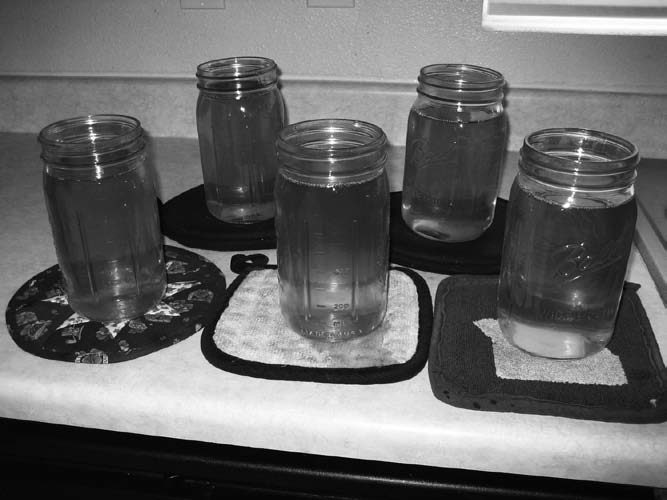
Warm rendered tallow.
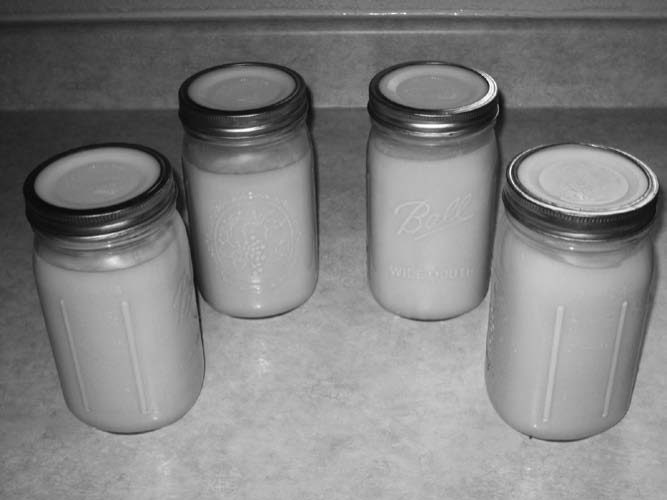
Cooled, hardened tallow.
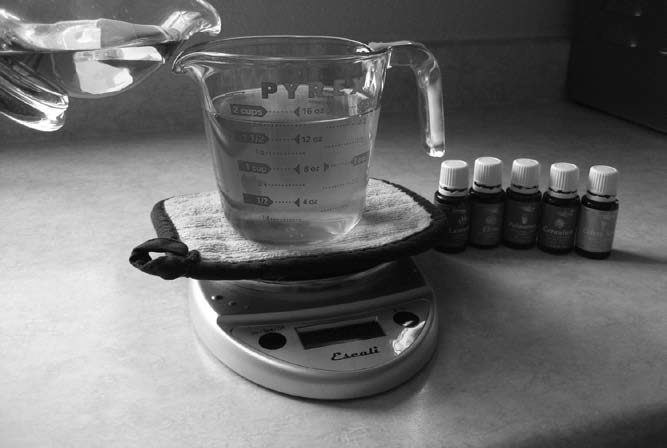
Adding olive oil to melted tallow.
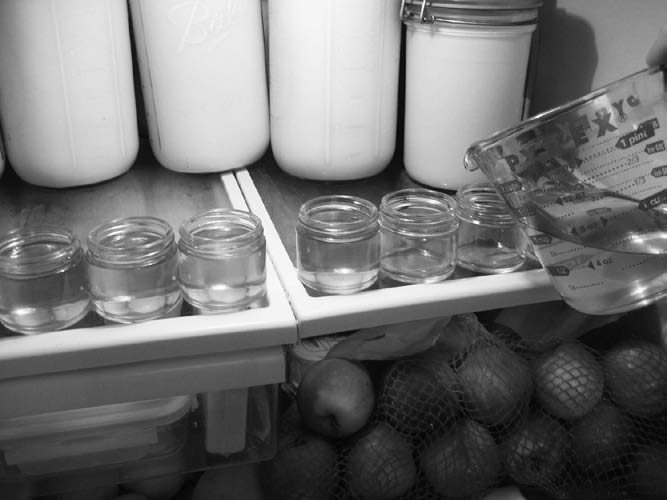
Tallow and olive oil mixture, in small jars.
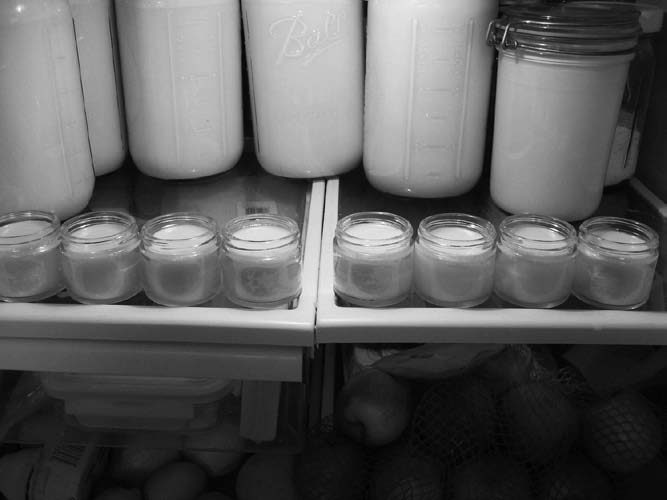
Solidified tallow balm.
Surely the quality of the tallow used in a balm would be of paramount importance to the therapeutic properties of the product. Since manmade toxins are found in nonorganically raised animals, it would not be wise to apply their fat to the skin (any more than to eat it) because of the risk of absorbing pesticides, antibiotics, hormones and all of their metabolic by-products. Furthermore, since Mother Nature knows best, it stands to reason that
if the animals are fed foods that are not natural to them, the nutritional value of their tallow would be compromised, even if such foods were technically organic.Indeed, tallow from cows that are only fed grass has a better mineral and micronutrient profile, including higher levels of vitamins. For example, one study found that grass-fed cows have four times the vitamin E of grain-fed cows.
32 Products from grass-fed animals were also found to have three to five times more CLA that those fed a "conventional" diet.33USING SKIN BALM MADE FROM TALLOWSince, as explained above, tallow is very compatible with our cell biology, it is readily absorbed by the skin. Therefore, applying tallow balm does not result in a greasy look or feel. It is taken up by the skin as nourishment and softens the skin quickly. Furthermore, a little balm goes a very long way, unlike with most commercial lotions that contain a large amount of very expensive water. A tallow balm can be applied anywhere on the body, including feet, hands, face, and even lips, so there is no need for multiple skin care products, not even a separate lip balm, since tallow is perfect for every skin care need.
It is interesting that, with modern skin care, a separate product is marketed for the face, presumably because it is gentler,
making one wonder if this is an admission to the harshness of the not-so-natural ingredients in the body lotions. A separate product is not necessary when it is truly from nature as tallow is.Diaper rash, before and after treatment with tallow balm.
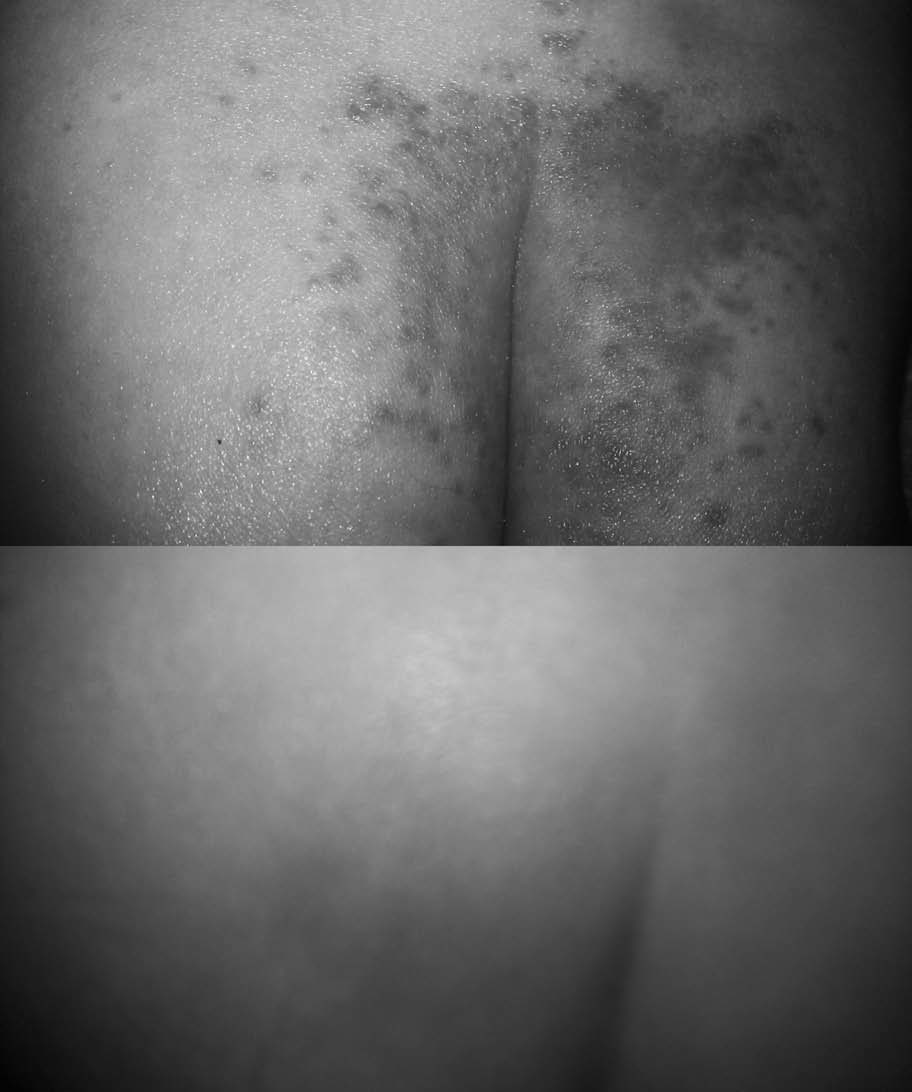
Tallow balm can be used for all manner of skin conditions, including dry, chapped, calloused, cracked and sun-damaged skin, rashes, burning, itching, wrinkles, and so on, because it gives the skin the nutrients it needs to heal itself. It can even be used as a soothing aftershave. One mother applied it all over her baby's body for eczema, which had been present for a couple months, and it disappeared. Another mother applied it on her baby for a terrible case of diaper rash that did not respond to other "natural" products, and it was gone after three applications. In addition, a man who had had a split lip for over a year and who had already "tried everything," including "natural oils and shea butter," had his lip heal in two weeks using tallow balm, and "it's been healed ever since." Finally, numerous others have had success using it for calluses, dry and cracked skin, and sunburns, and for moisturizing, smoothing and softening their skin.
HOW TO MAKE BALM USING TALLOWThe first step in making balm is to obtain tallow from pasture-raised animals (cows or sheep) that are 100 percent grass-fed. You can obtain tallow from your local farm or obtain the interior fat (suet) and render it yourself. There are different ways to render tallow, but I recommend this "secret," superior, and easy method: Cut up the suet into small pieces, excluding anything that isn't white. Place it in a colander or a vegetable steamer over a pot, and put the pot in the oven at 220°F. Leave the pot in the oven until all of the tallow has melted out of the suet, mashing and stirring once or twice during the process. The tallow will drip out into the pot. Filter the liquid tallow that is in the pot, placing a cloth in a new colander over a new pot and pouring the tallow through the cloth.
With the tallow in the liquid state but as cool as possible (around 120°F), thoroughly mix in the other pure, natural ingredient(s) of your choice to make the tallow softer and more spreadable at room temperature. (Pure tallow has a waxy consistency; candles used to be made from tallow.) Put the mixture in the refrigerator to let it solidify. This gives the balm a smoother consistency than letting it solidify at room temperature.
The amount of the other ingredient(s) that you mix with the tallow will depend on the ingredient and the degree of spreadability you are looking for. I use organic extra virgin olive oil in the proportion (by weight) of eight or nine parts tallow to one part olive oil. Olive oil has been considered a healing salve for the skin since ancient times due to its soothing, cleansing, and moisturizing properties. Olive oil is liquid at room temperature, so not much is needed to soften the tallow. If you use a product that is more solid, such as coconut oil, palm oil, or shea butter, you will need to use more, partially defeating the goal of having a balm high in tallow content. Whatever you use, be sure it is pure and organic. For example, coconut oil, palm oil, and shea butter are sometimes extracted using hexane, which is refined gasoline. Know your ingredients.
If desired, you can add essential oils to the liquid mixture as well. I add specific essential oils, such as lavender, which are known for their long-standing tradition of being healing to the skin. Another major benefit of using essential oils in your balm is to give it a fresh, pleasant scent and to neutralize the scent of the tallow, which is distinctive although not necessarily unpleasant. Since essential oils are extremely concentrated, not much is needed, but care should be taken not to use any that are adulterated, extended, synthesized or distilled using chemicals or high temperatures and pressure. For this reason, I use Young Living Therapeutic Grade essential oils. Again, it is important to know your ingredients and to remember the principle of using only those ingredients that are edible whole foods. You will be able to take pride in the fact that you could take out a spoon and eat this balm since it is a nourishing food for skin and body!
HARMFUL INGREDIENTS IN MODERN SKIN CARE PRODUCTSPETROLATUM or mineral oil jelly, along with mineral oil, a carcinogenic by-product of the distillation of gasoline from crude oil.
1PARABENS , known to mimic estrogen and suspected of being carcinogenic.
2BHT, a carcinogenic preservative,
3 which is also linked to allergic reactions, hyperactivity, rashes, asthma and toxicity to the liver and kidneys.
TITANIUM DIOXIDE ,
4 a carcinogen.
TRIETHANOLAMINE (TEA),
5 a carcinogen.
DMDM-HYDANTOIN , a carcinogenic formaldehyde releaser.
6METHYLISOTHIAZOLINONE , which causes nerve damage.
7SODIUM HYDROXIDE , which is lye or drain cleaner.
POLYSORBATE 80 and CETEARETH -20 are commonly contaminated with the highly toxic 1,4-dioxane.
8EDTA, a harsh detergent and hormone disruptor.
9PHENO XYETHANOL , which "can depress the central nervous system and may cause vomiting and diarrhea" in infants.
10DIAZOLIDINYL UREA , a preservative that releases carcinogenic formaldehyde
11 and can cause dermatitis.
12 (For skin care products, it is certainly ironic to find chemicals that cause dermatitis.)
PROPYLENE GLYCOL , associated with irritant and allergic contact dermatitis as well as contact urticaria (hives).
13BUTYLENE GLYCOL along with propylene glycol is a component of antifreeze.
HARMFUL INGREDIENTS IN "NATURAL" AND "ORGANIC" SKIN CARE PRODUCTSFRAGRANCE almost certainly synthetic, and such fragrances have been documented to be carcinogenic and toxic in other ways, causing headaches, dizziness, allergic rashes, skin discoloration, coughing, vomiting, and skin irritation as well as nervous system and behavioral effects.
14CHEMICAL PRESERVATIVES such as sodium benzoate and potassium sorbate. Sodium benzoate has many toxic effects on the body as outlined in its Material Safety Data Sheet (MSDS), and when combined with ascorbic acid (vitamin C), it forms benzene, a known carcinogen. Potassium sorbate is fundamentally non-toxic but can cause skin irritation per its MSDS listing. In any case, it seems that synthetic preservatives that inhibit the growth of micro-organisms would also generally not be beneficial to other living organisms such as humans.
VITAMINS, probably synthetic. Some studies published in Science,
The New England Journal of Medicine, and other journals suggest that some synthetic vitamins are toxic, and some extracted vitamins have been found to be useless since they need to be in a whole food form because the whole vitamin is a complex, not just the one molecule identified as the principal component.
POLYUNSATURATED OILS like safflower, sunflower, cottonseed, corn, soy, and canola. High heat is generally used in the production of these oils. Polyunsaturated oils are unstable, fragile, and susceptible to rancidity when subjected to heat, which causes the production of free radicals, associated with cell damage, aging and disease. Certainly, we do not want to be applying products high in free radicals to our skin, causing the very types of problems we are trying to relieve or prevent. And polyunsaturates would not seem to be conducive to skin health, extrapolating from the fact that the modern excess consumption of these types of oils leads to a host of health problems.
151,4-DIOXANE: This shocking hidden ingredient is not listed on the label. A carcinogen and a known eye and respiratory tract irritant that readily penetrates the skin, it is also suspected to be a kidney toxicant, neurotoxicant, and respiratory toxicant, among others.
There was a press release from the Organic Consumers Association (
www.organicconsumers.org) on March 14, 2008 entitled, "Carcinogenic 1,4-Dioxane Found in Leading 'Organic' Brand Personal Care Products." I believe this example could be considered the tip of a toxic iceberg, a discovery of the sort of thing that is probably happening with many of the other ingredients of skin care products.
According to Mike Adams, "A cancer-causing compound called 1,4-dioxane has been found in some of the most commonly used petroleum-based cosmetics by a study commissioned by the Organic Consumers Association, including products from Kiss My Face, Nutribiotic, Jason, Ecover, Citrus Magic, 365, Alba, Lifetree, Giovanni, Seventh Generation, Method, Earth Friendly Products, Sea-Chi Organics and many other brands. The explanation for the presence of 1,4-dioxane is that 'ethoxylation, a cheap short-cut companies use to provide mildness to harsh [harsh!?] ingredients, requires the use of the cancer-causing petrochemical ethylene oxide, which generates 1,4-dioxane as a by-product.' There are many labeled ingredients that imply the presence of 1,4-dioxane. To avoid 1,4-dioxane, the OCA urges consumers to search ingredient lists for indications of ethoxylation including: 'myreth,' 'oleth,' 'laureth,' 'ceteareth,' any other 'eth,' 'PEG,' 'polyethylene,' 'polyethylene glycol,' 'polyoxyethylene,' or 'oxynol,' in ingredient names."
Quoting a poignant passage from the same press release: "A visit to any health food store unfortunately reveals that the majority of products in the personal care section with 'organic' brand claims are not USDA-certified and contain only cheap water extracts of organic herbs and maybe a few other token organic ingredients for organic veneer. The core of such products is composed of conventional synthetic cleansers and conditioning ingredients usually made in part with petrochemicals. According to market statistics, consumers are willing to pay significantly more for products branded 'natural' or 'organic' which they believe do not contain petrochemical-modified ingredients or toxic contaminants like 1,4-dioxane. . . When it comes to misbranding organic personal care products in the U.S., it's almost complete anarchy and buyer beware unless the product is certified under the USDA National Organic Program."
16REFERENCES1. International Agency for Research on Cancer (27 March 2012).
Agents Classified by the IARC Monographs, Volumes 1 - 104: 20.
2. Harvey PW, Everett DJ (Jan 2004). "Significance of the detection of esters of p-hydroxybenzoic acid (parabens) in human breast tumours."
Journal of Applied Toxicology 24 (1): 1 - 4.
3. International Agency for Research on Cancer (1986). "Butylated hydroxytoluene (BHT)"
IARC Monographs on the Evaluation of Carcinogenic Risks to Humans 40:161-206.
4. "Nanoparticles Used in Common Household Items Cause Genetic Damage in Mice"
Science Daily 16 Nov. 2009.
5. Stott WT, Radtke BJ, Linscombe VA, Mar MH, Zeisel SH (2004). "Evaluation of the potential of triethanolamine to alter hepatic choline levels in female B6C3F1 mice."
Toxicol Sci 79 (2): 242 - 7.
6. Epstein, MD, Samuel S. (2009).
Toxic Beauty: How Cosmetics and Personal-Care Products Endanger Your Health... and What You Can Do About It. BenBella Books, Inc., Dallas: 33.
7. Shen Du, BethAnn McLaughlin, Sumon Pal, Elias Aizenman (2002). "In vitro neurotoxicity of methylisothiazolinone, a commonly used industrial and household biocide, proceeds via a zinc and extracellular signal-regulated kinase mitogen-activated protein kinase-dependent pathway."
Journal of Neuroscience 22 (17): 7408 - 7416.
8. Epstein: 33.
9. Epstein: 34.
10. U.S. Food and Drug Administration (23 May 2008). "FDA Warns Consumers Against Using Mommy's Bliss Nipple Cream." FDA News Release.
11. Epstein: 33.
12. Lehmann, Søren Vig; Hoeck, Ulla; Breinholdt, Jens; Olsen, Carl Erik; Kreilgaard, Bo (2006). "Characterization and chemistry of imidazolidinyl urea and diazolidinyl urea."
Contact Dermatitis 54 (1).
13. Epstein: 39.
14. Epstein: 93.
15. Fallon, Sally, Enig, Mary G., PhD (1 Jan. 2000). "The Oiling of America" section: "Dangers of Polyunsaturates". (
http://www.westonaprice.org/know-your-fats/the-oiling-of-america#poly)
16. Organic Consumers Association (14 Mar. 2008). "Carcinogenic 1,4-Dioxane Found in Leading 'Organic' Brand Personal Care Products" Press Release. (
http://www.organicconsumers.org/bodycare/DioxaneRelease08.cfm)
17. Chase, Alvin Wood, M.D. (1866).
Dr. Chase's Recpies; or Information for Everybody, 33rd edition. Published by the author, Ann Arbor: 110-112, 162-163.
18. Chase: 174.
19. Price, DDS, Weston A. (2000).
Nutrition and Physical Degeneration. Price-Pottenger Nutrition Foundation, Inc., La Mesa.
20. Fallon, Sally, Enig, Mary G., PhD (2001).
Nourishing Traditions. NewTrends Publishing, Inc., Washington: 11.
21. Fallon: 18.
22. James, William D.; Berger, Timothy; Elston, Dirk M. (2006).
Andrews' Diseases of the Skin: Clinical Dermatology. Saunders Elsevier: 7.
23. Cheng JB, Russell DW (September 2004). "Mammalian Wax Biosynthesis: II. EXPRESSION CLONING OF WAX SYNTHASE cDNAs ENCODING A MEMBER OF THE ACYLTRANSFERASE ENZYME FAMILY"
24. Ip, C, J.A. Scimeca, et al. (1994). "Conjugated linoleic acid. A powerful anti-carcinogen from animal fat sources."
Cancer 74(3 suppl):1050-4.
25. Fallon: 19.
26. Enig, Mary G., PhD (Winter 2007).
Wise Traditions in Food, Farming and the Healing Arts. "Some Recent Studies on Fats."
27. Enig, Mary G., PhD (Spring 2004).
Wise Traditions in Food, Farming and the Healing Arts. "The Importance of Saturated Fats for Biological Functions."
28. Personal Care Products Council. "Stearic Acid". (
http://www.cosmeticsinfo.org/ingredient_details.php?ingredient_id=12)
29. Anneken, David J., Both, Sabine, et al. (2006). "Fatty Acids."
Ullmann's Encyclopedia of Industrial Chemistry. Wiley-VCH, Weinheim.
30. Personal Care Products Council. "Sodium Stearate." (
http://www.cosmeticsinfo.org/ingredient_details.php?ingredient_id=961)
31. Personal Care Products Council. "Glyceryl Stearate." (
http://www.cosmeticsinfo.org/ingredient_details.php?ingredient_id=498)
32. Smith, G.C., "Dietary supplementation of vitamin E to cattle to improve shelf life and case life of beef for domestic and international markets". Colorado State University, Fort Collins.
33. Dhiman, T. R., G. R. Anand, et al. (1999). "Conjugated linoleic acid content of milk from cows fed different diets."
J Dairy Sci 82(10): 2146-56.
Reader Comments
to our Newsletter